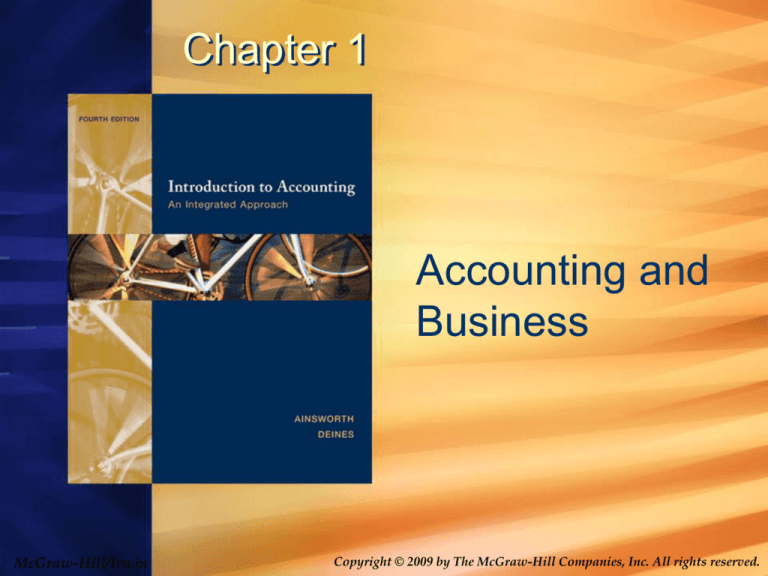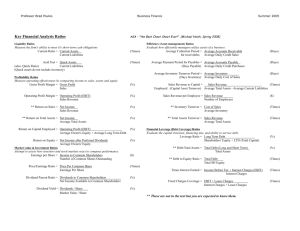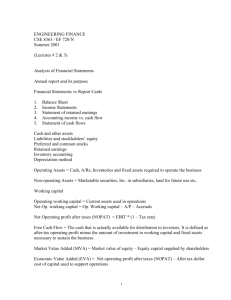
Chapter 1
Accounting and
Business
McGraw-Hill/Irwin
Copyright © 2009 by The McGraw-Hill Companies, Inc. All rights reserved.
Bell Ringer………
1. Pick up and complete vocabulary matching
worksheet.
2. Pick up a copy of Formula Guide and outline.
3. Pick up a vocabulary flashcard and stand under
the appropriate financial statement poster that
relates to your flash card.
1-2
Essential Questions
1. How does financial ratios help users of
financial statements? Explain.
1-3
Students will be able to:
• Explain the purpose of financial ratios.
• Define and calculate the current ratio and
debt-equity ratio.
• Define and calculate return on sales (net
profit margin) and return on equity.
• Examine and discuss calculated financial
ratios.
1-4
What are the Purposes of the Ratios? How
do they help users of financial statements?
• Current ratio Relationship between current assets and
current liabilities
Measures Liquidity and reflects company’s
ability to satisfy its current obligations/ debt.
CURRENT ASSETS
CURRENT LIABILITIES
Example: Apple 2008 $34,690 = 2.46
$ 14,092
Apple had 2.46 of current assets for
every $1.00 of current liabilities
1-5
What are the Purposes of the Ratios? How
do they help users of financial statements?
• Return on sales
Relationship between net income and sales;
measure of profitability (ability to generate profit
from sales)
NET INCOME
SALES
1-6
Example: Apple $4,834 = 14.88%
32,479
Apple generated 14.88% profit per $1 sales or
.15 of every $1 is profit.
What are the Purposes of the Ratios? How
do they help users of financial statements?
• Debt to equity ratio
Relationship between liabilities and owners’
equity; measure of company solvency (ability
to pay both short- and long-term obligations)
1-7
More debt a company has, more profits it must
generate to pay the interest on debt and the
greater risk for shareholders.
TOTAL DEBT
TOTAL SHAREHOLDERS’ EQUITY
What are the Purposes of the Ratios? How
do they help users of financial statements?
• Debt to equity ratio
TOTAL DEBT
TOTAL SHAREHOLDERS’ EQUITY
Example: Apple $18,542 = $.88
21,030
Apple had .88 of current and long-term debt for every
$1.00 of shareholders’ equity.
Ratio 1 to 1 = half company’s assets are financed with
debt and half with shareholders’ equity.
1-8
Lecture Examples
3.Using the amounts shown in Lecture
Example #2, calculate the current ratio, the
debt to equity ratio, and the return on sales
ratio.
Answer:
Current ratio:
Debt to equity ratio:
Return on sales ratio:
Lecture Examples
2.Describe each of the following items and
determine which financial statement it
appears on.
Accounts payable, $136
Building, $809
Accounts receivable, $876
Cash received from customers, $13,074
Cash paid for inventory, $8,338
Cash paid to employees, $1,724
Cost of goods sold, $8,192
Inventory, $908
Miscellaneous operating expenses, $3,686
Sales, $13,353
Wage expense, $1,750
Patent, $2
Long-term bank loan, $716
Common stock, $3,827
Retained earnings, $373
Cash balance, $2,211
Miscellaneous payables, $529
Essential Questions
1. How does financial ratios help users of
financial statements? Explain.
1-11
Students will be able to:
• Explain the purpose of financial ratios.
• Define and calculate the current ratio and
debt-equity ratio.
• Define and calculate return on sales (net
profit margin) and return on equity.
• Examine and discuss calculated financial
ratios.
1-12
HOMEWORK…….
• Finish final section of skeletal outline page
6.
• Complete E1.9 & 1.17
• Complete Case 1A
• THANK YOU!!!!!!






